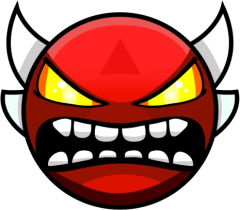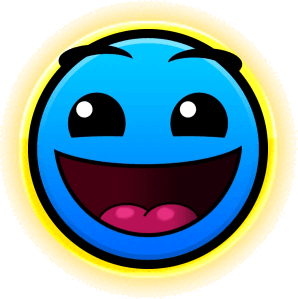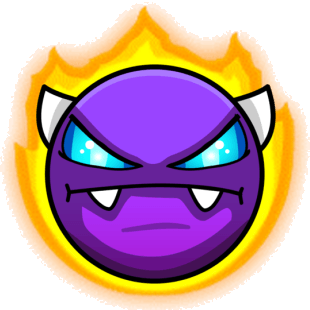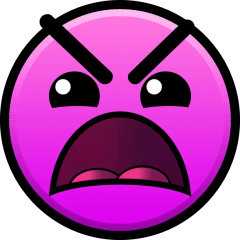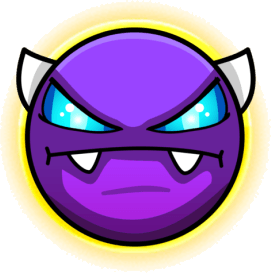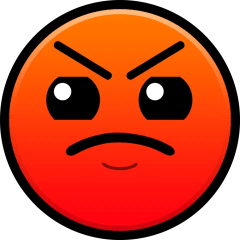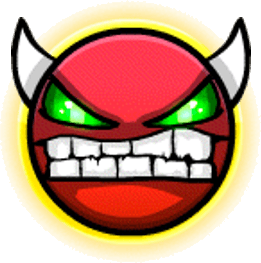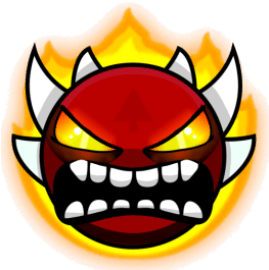Moderator
Rating Curve
Filters
Reviews
I love how much energy is crammed into this level. The designs are pretty unrefined, consisting of a lot of default 2.0 metal and animated blocks that tend to clash pretty hard with the candy-like environments and the very bright rainbow colours chosen, but the level puts its focus on general movement and energy enough that it doesn't really matter. The gameplay is consistently fast-paced and high-intensity, and the choice to use duals at the peaks helps a lot in this regard too. I appreciate the choice to not include too many strict timings, as it lets the player focus more on building a click pattern and enjoying the flow of the level based on muscle memory, which is great for this sort of high-intensity gameplay (as long as it's not strictly click synced - Mint Candy's gameplay is synced more with its movement than clicks, with the icon moving more in line with the pitch and intensity of the synths, which for me is a much more fluid and consistent form of sync for intense gameplay). Everything is balanced quite well, with no noticeable choke points and a good balance of gamemodes depending on what the song calls for - ship for long notes, wave for arpeggiated sections, etc. I really appreciate how much this level feels like it's designed for the player. It's a super enjoyable experience all around, despite looking a little rough, and one of the most fun insane demons I've ever beaten. I'd recommend this for Epic if it wasn't already
While very nice to see some aromantic representation, I don't have much else to say about Aroma. The overgrown architecture seen throughout the level is a nice thematic decision, as the calmer song brings to mind tranquil environments like a garden or a forest, which the visuals do capitalise on. The secondary design elements like the hedges in the last two parts add a bit of depth despite the very flat designs, and also help the mainly grey and light green block designs contrast much better with their surroundings, as the dark green leaves make them pop much more than the lighter green backgrounds.
Aroma's other aspects, though, are not very noteworthy. The first two parts are quite standard modern designs save for the aromantic flag's colour scheme, the gameplay is effectively stock standard despite being balanced well, and the designs themselves do the job of bringing to mind the aforementioned themes of the level, but nothing more due to their lack of detail, interesting structuring shapes, movements, effects, etc. Aroma is overall a forgettable level; while not particularly bad in any area, it doesn't stand out in any way either. I'd recommend this for Star Rate.
In the interest of avoiding spoilers, I won't talk much in detail about how this level connects with Deltarune, but it is heavily based on a section of one of the game's chapters. In terms of technical execution, the level of detail is on par with the source material, and I quite appreciate the additional lighting effects on the church windows and the saws to make them pop from the darker background. The added background texturing is nice as well, as particularly in the ship at 0:45 the layered, floating particles feel almost like dust or stars and give the illusion of the level having far greater depth than it does, which helps the environment feel grander.
This is what makes Prophecy quite a one-dimensional level, though, as it sticks to its source material very faithfully rather than taking advantage of the GD editor to provide a more unique experience. The few rhythmic elements in the level aside from the gameplay are elements already present in game, and in particular I would have loved to see more usage of the rings as an "echolocation" gimmick as they have quite a large presence in the original chapter, yet only appear in parallel to the scripted intro sequence. I'd also have liked the level to feel more distorted and fragmented akin to the second sanctuary - the whole concept of it being a reflection is unseen in the level in favour of the more basic, overall church theme that was chosen. Not to say what's here is bad, I just think it's missing a lot of potential that it could have achieved by taking the chapter's mechanics and environment and turning them into a more complete, unique experience by taking advantage of more of what the editor offers. I'd recommend Prophecy for Feature.
Thematically, Corruption is quite one-dimensional, focused around a malicious program destroying (presumably) the level. This is conveyed to the player through broken code, copious glitching effects in both the foreground and background, and some memory sections with broken, monochromatic decoration. I like some aspects of this; I think the theme is best translated through the block designs, such as the part at 0:14 where the design interiors are constantly glitching and shifting, and some of them even completely fall away or break apart. This does a good job letting the player know what the overall theme of the level is, while also adding a layer of memory to the level to confuse the player as the structuring layout is quite wacky and unintuitive, which feels like something malware would naturally do.
However, the overall execution of the theme is pretty lacklustre. The theming is quite inconsistent between parts; the aforementioned block design effects are never used again throughout the level in favour of more typical squares/rectangles connected by lines, and while this does still resemble technology, it sticks out noticeably against the aggressive glitching used in the backgrounds of most of the midsection. I also think the inclusion of the text and code segments left a lot of potential out; Killbot (which is a clear inspiration for this level) used code to turn the whole level into something resembling a bossfight as the virus is constantly messing with the level and the player (there's even a whole deletion sequence at the end to finish off the level in a satisfying way). Here, it feels more like an afterthought and really only serves as an occasional visual accent, with the smooth animations on the windows feeling pretty out of place, and the actual code being used infrequently enough to not feel important. The text as well feels too edgy for something themed around malware, with the massive "why won't you stop" and "critical failure" setpieces particularly standing out as feeling quite out of place. In general, I just wish this level went all in with a specific idea like Killbot does, rather than trying to maintain a specific aesthetic and "edgyness" while still using some elements of malware, as it leaves the level lacking on both fronts. I would not recommend this for rate, but it's far from a bad level and I'd be interested to see TacticalFahrrad's current and future works.
The pop culture mosaic that is the "dreamcore" aesthetic is something I rarely see translated into Geometry Dash, but Fat Donkey does a decent job of it. The most defining aspect of dreamcore to me is the omnipresent shifting rainbow colours, and I appreciate how in this level most of the details that are coloured in use unique hue offsets as to not use the same colour at all times. In particular, I love contrast between the very saturated snaking trail around 0:30, the multicoloured, lighter ground spikes and the block designs that feel like little windows into desktop backgrounds or popular video games. These all combine to create a lot of visual distinction between each major element, while also nailing every element of the "dreamcore" style pretty well - I like the inclusion of the pop culture references in the block designs, as it gives each design some space to shine as the player's eye is naturally drawn to them due to them serving as hazards.
I also quite like how varied DwcA's approaches to the style become throughout the level. 0:44 has the song's increased energy and warbling synths sync alongside lots of very trippy shader effects, exploding block designs and hallucinogenic backgrounds (especially the giant blinking eye), making for a much more abstract and dreamlike part. The following part's spinning vortex of space viscera and even greater shader usage, especially the bulge shader to give an unnatural sense of depth to the part, works well off of the previous part exploding into nothingness and still feels very dreamlike due to the unnatural shaders and the flying space debris. Lastly, parts like 1:13 feel straight out of an old early 2000s website, with bright, saturated rainbow colours, heavy emphasis on lineart and a lot of very roughly drawn art of cats. All of these parts, while very much rough around the edges and sometimes lacking in terms of more traditional elements (I'm not big on the block designs around 1:01), still does a great job at replicating the main elements of the dreamcore aesthetic in the context of a GD level. Fat Donkey is a fascinating experience and I would recommend this for Feature. Go play it!!
TRANCE TRANCE is something I resonate with surprisingly heavily, considering how abstract most of its storytelling is. I like the fact that it leaves itself quite open-ended and up to the player's interpretation, but from what I've gathered it deals with the experience of one coming out as trans and being themself, something I'm very familiar with. I appreciate the usage of blue and pink near the beginning to express this - the very dull, foggy blue definitely sells a sense of discomfort that the brighter pink or pink-white-blue sections lack. I especially like how much more open and energetic the level becomes during the climax, with the blue-white-pink flashing colours on full display and the level generally feeling much more alive and sure of itself, so to speak. I don't know whether this is the impact the level is supposed to have on the player, but I do love more open-ended forays into storytelling as it allows everyone to draw their own parallels to the events that play out, and helps make it that much more meaningful.
In terms of the actual level design, the pixelate shader is a bit of an odd touch - the level is vaguely themed around technology, but not to such an extent that I feel the harsh pixelation effect adds much beyond blurring some of the level's details. It does make the level feel more like a lower budget indie game, which is charming in its own right but again doesn't do much for me. The exception to this is the ending, as the increased pixelation here makes the part feel more like a blurry memory or a scrap, which lines up somewhat with the dialogue and the part slowly disintegrating into the "secret ending" of sorts, which is a nice touch.
The choice to use three separate songs for the most distinct sections of the level is one I love seeing people explore, and for the first two songs I think it works quite well as the Cacola song found in the second part feels much more hopeful and bright than that of the first, nicely aligning with the themes of taking back self control and finding yourself. The third part is one I don't like as much, as while I like the amount of depth and variation in the backgrounds and structuring styles, I don't think this is very conducive to the brash, repetitive Tanger song that was chosen, and it makes this part feel lacking in having a strong identity or direction. Overall, though, TRANCE TRANCE is a super fascinating level and quite a sweet exploration of the trans experience as a whole. I'd recommend this for Feature or Epic and will be keeping up with OctoAngel's works going forward.
The only strong descriptor I have for this level is that it's very clean. Every element of Wand takes a very simplistic approach with flat, muted colours, little movement and very simple structures and designs reminiscent of the peak of the modern style around 2020. I appreciate how well balanced the level of details are across each part, as the simpler, tiled designs are complimented by subtle, geometric background texturing that helps fill in some of the excess negative space.
Aside from that, there's not much on offer. The gameplay is quite standard, containing nothing particularly engaging and no notable song representation or unique gimmicks. The decoration is quite stock-standard aside from the high level of cleanliness, and feels very monotonous as the general style, colour scheme and structuring conventions don't change at all throughout the level. Wand would really benefit from a bit of experimentation in any of its major elements, a unique gimmick or bold colour choice can go a long way towards making a level special.
We love a good puzzle level. Honestly, I cannot for the life of me figure out how to solve this, so I can't comment much on the actual puzzle design, but aesthetically this ticks just about every imaginable box. Using an alien language for the codes is a good way to add more mystery to the puzzles, and combined with the vaguely industrial backgrounds and the low-quality CRT-like display the player has access to does a good job at making PAIN CONTROL BUS feel like you're tasked to solve an impossible puzzle in an alien civilization. I like this, as it adds more mystery and provides a pretty unique setting for the level.
The emphasis on the impossible part is important - it adds another layer of stress and panic as you're forced to solely rely on memory and pattern recognition rather than any linguistic skills. This is accentuated by the ticking timer and the slow, burning build of both the song's intensity and the progressive breaking down of the level as the colours shift from blue to red and the screen distorts. All of this makes PAIN CONTROL BUS a really enthralling experience (despite my absolute inability to actually solve it), and one of the most stressful levels I've ever played despite the lack of any traditional gameplay. The payoff at the end is really nice, too, as the colours fade to white and the level slowly fades away as if expressing its own sense of relief at being solved and averting whatever consequence might have followed failure. I would recommend this level for Legendary, and think all other puzzle-type levels should take notes on what I previously mentioned makes this such an effective experience.
I really want to touch on the beginning's dual gameplay where the other icon asks to race the player to the moon. This is some of the best thematic setup I've ever seen in a level, and establishes a clear motive and overall trajectory for the level in a way that is both natural (due to the part being dual) and silly. Visually, Dyad is overall quite a silly feeling level, as the decoration style leans heavily into abstraction in most parts. The crunchy, pixelated textures on the "ground" objects in both the earth and moon sections establish a lean away from realism to the player immediately, and plenty of other elements like the shooting stars in the space sections and the giant spinning rainbows in the sky section move or appear in absurd ways that make the player's journey feel more like fantasy, which is nice considering the "race to the moon" theme is quite an unrealistic one outside of a fantasy setting. (edited)
I absolutely love how unafraid Awesomeme360 is to use repetition in this level for song representation (mainly concerning gameplay, but occasionally visuals too). The song uses quite a repetitive drum line and a simple vocal chop that loops and only really changes in time with the level's major visual changes from part to part. The cube gameplay in the beginning section with the groups of three "staircase" blocks serve to represent this repetition, and often they make up 10-15 sections of the level with nothing but that structure repeated when the song calls for it, however orbs and pads are frequently used to create unique gameplay on top of those repeating structures in time with any one-off effects or noteworthy elements of the song. This is not only fantastic for song representation in all regards, but helps keep the player engaged by breaking up the monotony that comes with repeated gameplay.
Lastly, Dyad is great at making the player feel small. Aside from just the overall huge verticality of the level, some set-piece elements in each part are huge and take up multiple screens' worth of space, which helps to reinforce the size of the environment to the player. My favourite example of this is the cloud ring in the UFO section, as it still feels natural and connected with the part because of the general heavy use of clouds in that section, despite the absurdity of a giant ring of clouds appearing in front of the player. Dyad is a fantastic, surprisingly concise and very silly experience, and one with genuine replayability due to the complexity of its world. I would recommend this for Legendary and look forward to more from Awesomeme360.
Right off the bat, big feet excels in its structuring and designs. Most of the level's main designs used sharp outlines, flat, bright accents and a darker (usually black) backing colour reminiscent of older cel-shaded comics, and this is perfectly complimented by the harsh angles and free-floating lines that most of the structures used. In particular, the ship at 0:44 reminds me of impact effects, and the circles in the background look like cel-shading gradients. Even the structures that don't fit this mold have other visual tie-ins to this theme: the speakers at 0:31 lack outlines and use cel-shaded highlights to appear more cartoonish, and the large pink structures at 0:53 reuse the same circular cel-shading technique previously mentioned. I appreciate the overall consistency and attention to detail in the level's main structures and designs, and it creates an extremely visually cohesive product.
The detail balancing in big feet is also on point. Every part has lots of contrast between multiple distinct layers, and this is easiest to see at 0:53. Starting from the front, the pulsing black and white concentric circles are a nice, sharp accent detail that stands out from the pink main structures beneath them, which make up the bulk of the screen. Some of the structures also have blobs of purple behind them, which works nicely as a layer to create more distance between the main structures and the background, and helps fill some excess negative space. Lastly, the background has some subtle texturing with spinning stars and grainy glow that provides a little bit more detail to the sections of negative space.
While the level doesn't incorporate the level's lyrics into its visuals much, the lyrics being placed on screen and interacting with some of the decoration (like the TVs about halfway through which show objects relevant to the lyrics) are nice details that do help tie them into the level naturally, and the gameplay mainly syncing to the lyrics also helps in this regard. Overall, I have no real issues with big feet - it's not an extraordinary level, but it's very well rounded and an excellent showing from AudieoVisual. I would personally recommend this for Epic.
GDPR Cookie Consent
Hyperbolus uses cookies and local browser storage to enable basic functionality of the site. If we make any changes to these options we will ask for your consent again.
sorry about this gang
